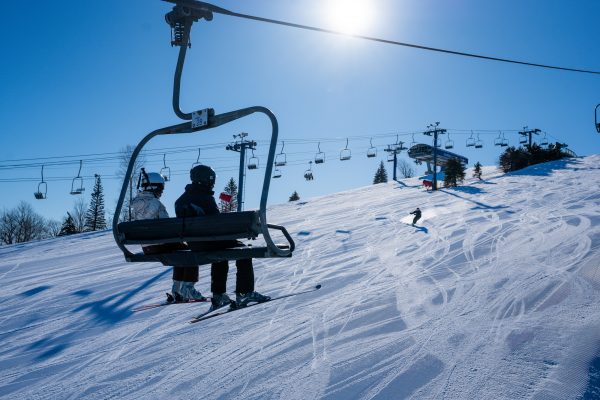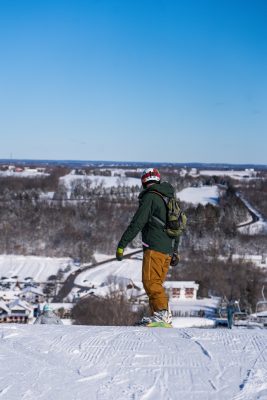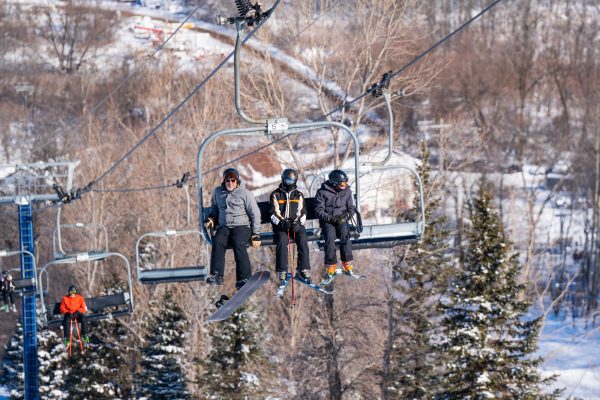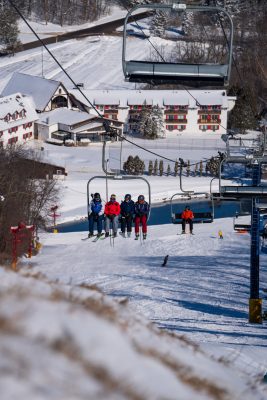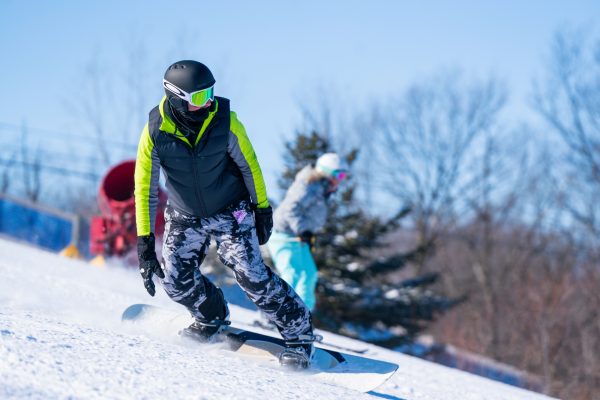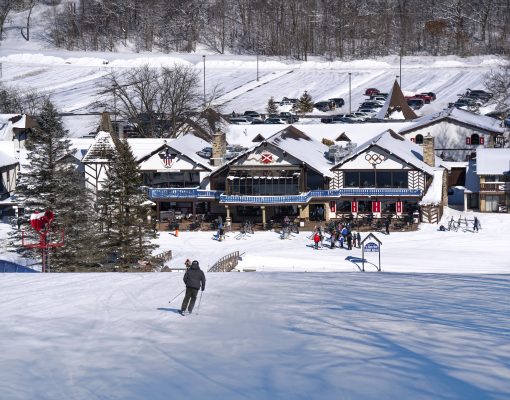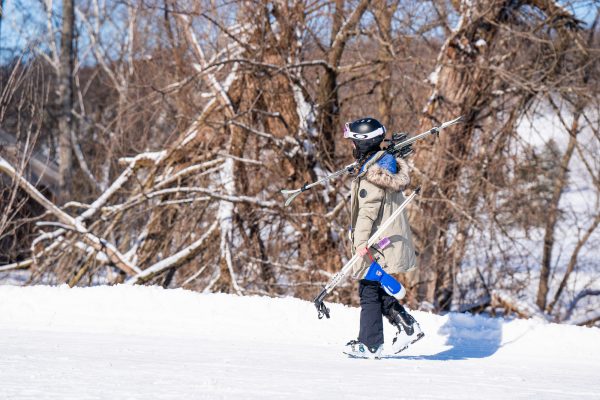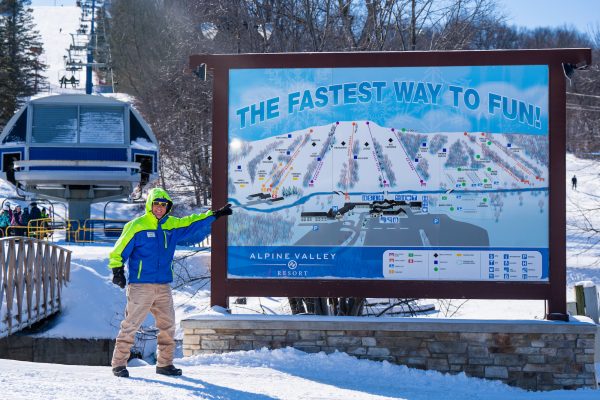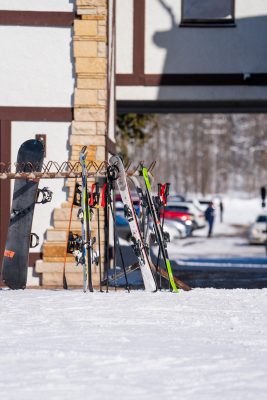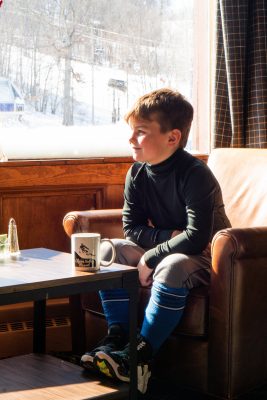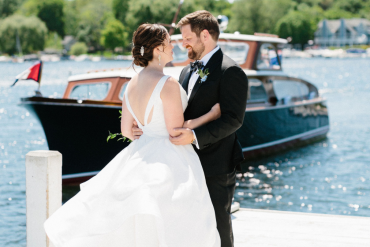By Kristine Hansen | Photos by Holly Leitner
Harold Friestadt of Williams Bay is what you might call an “avid skier,” having inherited his love of the sport from his father, who was born in Norway. The 84-year-old is a prolific cross-country skier; he’s competed in the American Birkebeiner race 33 times, completing 28 of those attempts, and he’s even flown to Norway to compete in the Norwegian Birkebeiner. Closer to home, however, Friestadt’s passion is downhill skiing. Every morning in the winter, almost without fail, Friestadt is up early, hopping in his car (license plate: SNOW SKI) to head out for some early morning runs. His destination: Alpine Valley Ski Resort in East Troy.
The hills at Alpine Valley open at 9 a.m., and Friestadt says he’s at the resort by 8 a.m., to ski a minimum of 23 runs per day. “I ski every day they’re open,” he explains, pointing out that the winter weather plays a role in the number of days he can downhill ski locally. In his most prolific season, he skied 100 days. During the 2022-2023 season, he skied 79 days. Friestadt has no intention of letting age slow him down. “I’ll be 84 for the ski season this year,” Friestadt said back in August, which is also the time of year he buys his annual Alpine Valley Ski Resort pass, to snag lower pre-season rates.
OUT OF THE GATE
With any mention of Alpine Valley, two images emerge: skiers and snowboarders cresting down white hills in the winter, or music fans rocking out to concerts by internationally revered bands in the summer. Despite locals’ familiarity with Alpine Valley Ski Resort and Alpine Valley Music Theatre, the history of this world-renowned spot remains lesser known. In December of 2024, Alpine Valley Ski Resort will officially celebrate its 60th anniversary, so we wanted to take a look back on how far this resort has come since its 1964 debut.
Ski and Snowboard Director Bruce Firestone has been involved with the ski resort since its early beginnings. He now manages it as a partner with Wisconsin Resorts, Inc., which today owns the ski resort side of the business. In fact, Firestone’s uncles — Joseph Kosik and Willis Stoick — were the founders of Alpine Valley, but it didn’t start out in Wisconsin. First, Alpine Valley debuted in White Lake, Michigan, close to where the two men were born and raised.
One of Firestone’s uncles had learned to ski while stationed at a United States Air Force base in Germany, and he longed to bring that sport to the Midwest. So he built a ski lodge near Detroit. “But he realized he wanted a bigger hill, and bought some other land in 1960 near Pontiac, Michigan, called Alpine Valley,” explains Firestone. “It was a big hit outside of Detroit. He said, ‘That formula’s working. Why not bring this to the Chicago area?’”
That’s when Firestone’s uncles started looking for a Wisconsin location for Alpine Valley, convenient to the Chicago market. At first, they didn’t know where exactly to expand in Wisconsin. Fortunately, one of their suppliers had an idea. “My uncle was buying a chairlift and asked the company selling it where he could build a ski hill,” says Firestone.
With great nostalgia, Firestone recalls how the current site for Alpine Valley and its surrounding land used to look. “There were cows grazing,” he describes. “Nothing was really here other than the farms you see around it.” (The sloping shape of the land was formed by receding glaciers during the last Ice Age.)
The ski hill opened on Dec. 5, 1964, and was an almost immediate success. Two years after opening, the brothers
added a 30-room resort and an 18-hole golf course to the property. “At the time they called [the Michigan resort] Alpine Valley East and this was Alpine Valley West,” says Firestone. Two years after that, Firestone’s uncles expanded their business again, this time opening a resort in the Madison market. “In 1968, [Alpine Valley Ski Resort] was so successful that they went up the road north of Madison and built another hill called Devil’s Head Resort,” Firestone explains. Devil’s Head Resort is still in business today and is now owned by the son of an original partner.
BARRELING FORWARD AT TOP SPEED
Firestone says he started working with his uncles at Mount Holly, one of their properties north of Detroit, in the early 1970s. By this time, they had a thriving portfolio of ski hills across Michigan and Wisconsin. Then, in 1977, the brothers opened Alpine Valley Music Theatre on their property in East Troy. The seasonal, outdoor-music venue hosted 36 shows that summer, including Neil Diamond, Bob Seger, Neil Young and Linda Ronstadt, and was the country’s largest amphitheater at that time.
However, the wild success of the music venue created tension between the brothers, who disagreed about how — or if — to expand it. So in 1979, the brothers made a change in ownership. “One partner kept Alpine Valley in Michigan and Devil’s Head,” says Firestone. “The other partner kept Mount Holly in Michigan and Alpine Valley in Wisconsin.”
Eventually, the music venue became too unwieldy for the family-run business to continue operating. “We ran it for 10 years,” Firestone says. “I literally helped build it and run it. But that got sold in 1986. We got out of the music business.”
THE PERFECT POWDER
In the 1980s, Firestone became a partner in the family business by further developing a ski resort near Kalamazoo, Michigan. He also helped design and procure a patent for a snow-making machine that was superior to others on the market. “It allowed us to make better snow, more cheaply, and open earlier,” he says. It was a defining moment for Alpine Valley, as many other midcentury-era ski resorts began to fold around the same time.
“Most of the ski stuff became very popular after World War II,” Firestone explains. “The GIs came back and had been exposed to more venues. At the same time, [people were] skiing in St. Moritz where the rich and famous could ski. [There was a need for] smaller places you could go and be glamorous in your backyard.” This led to a boom in demand for ski hills.
“There were a ton of ski hills in the mid ‘60s through the mid ‘70s,” Firestone continues. “Vail Ski Resort opened in 1962,” he adds, citing one of the greatest success stories of this era. (Today, Vail Resorts owns 41 ski resorts around the world and claims 32 percent of the market share.) However, many of these midcentury ski hills did not survive, struggling to keep up with changing technology and equipment improvements.
Today, most of Alpine Valley’s local competitors have closed or been sold off. Firestone says those operations didn’t have the funds or space to continue to improve by building additional infrastructure. “At Majestic [Hills Ski Area], they didn’t have enough parking at the bottom, for example,” explains Firestone. “Hawks’ View was not as big a hill as Alpine. Wilmot Mountain is one of the oldest — they started in 1937, pre- World War. II,” he says, but notes that Wilmot was acquired by Vail Resorts in January 2016.
Not far from Alpine Valley in rural Lyons Township, Grand Geneva Resort and Spa’s Mountain Top Ski and Adventure Center is today owned by the Marcus Corporation, but Firestone says that ski area was originally inspired by Alpine Valley. “Hugh Hefner wanted to come to this property when we started it [in the 1960s]. He wanted to build a hotel and make it a nightclub, plus skiing, because skiing was so popular then. Obviously, that didn’t happen here, but he built the Playboy Club with its own ski hill down the road, at what is now Grand Geneva.”
IT’S ONLY ROCK ‘N ROLL
After Firestone’s uncle sold Alpine Valley Music Theatre in 1986, the 240- acre venue went on to greater and greater fame, becoming one of the best-known outdoor music venues in the country, as well as the site of a tragic helicopter accident that took the life of guitarist Stevie Ray Vaughan. “[It’s] changed hands four times and [is] now owned by a Florida-based investment group and operated by Live Nation,” says Firestone. The capacity has been expanded to accommodate around 37,000 people, making the economics of filling the seats more challenging. “Back in the day, when we ran it [as a smaller venue], we [had] shows every week. In today’s world, the theater seats almost 40,000 people. Today there’s very few groups that can even fill 30,000 seats.” Instead, today the venue hosts these larger (and more lucrative) concerts less frequently, averaging about three to five shows per summer since Live Nation took over.
One factor that has led to the amphitheater’s continued success is the booking of annually recurring shows. From the 1980s through the early 2000s, many rock bands would book several nights of shows at Alpine Valley, their fans traveling from around the Midwest and the United States to camp on the property and attend some or all of the shows. The Grateful Dead played at Alpine Valley 20 times between 1980 and 1989. Phish has performed 23 times. The Dave Matthews Band has frequently hosted two-night engagements at Alpine Valley, starting in 1999. On top of this, many bands have chosen to record concerts or music videos at Alpine Valley, including the Grateful Dead, Motley Crue, the Black Crowes and Korn.
ONWARD AND UPWARD
Firestone feels that selling the music venue allowed the partners to focus on making the ski hill the best it could be. He says that the same year that they sold the venue, “we put [additional] dirt on top of the hill to make it bigger, and put in more lifts and more snow- making equipment to accommodate it. It went from [a height of] 260 feet to about 360 feet.” Today, the ski area boasts more than 100 skiable acres with 20 runs that range from beginner to expert, plus three terrain parks for snowboarders. To get guests back to the top of the hill, there are three high- speed quads, four triple chairlifts, two rope tows and five beginner “magic carpets,”plusafunsnowcarouselfor kids. In addition to Alpine Valley’s 110- room hotel (opening for the season this year at the end of December), the resort also offers multiple on-site dining options, including: an indoor café and coffee shop, the Valley View Lounge and the Alpine Bistro, a refined, indoor fireside dining experience.
So what’s next for Alpine Valley? “We’re always improving,” Firestone explains. “We built a new pavilion. We changed all of our carts to electric carts two years ago. There’s plans in the works to remodel the hotel in the next two years.” A celebration of the 60th anniversary is also in the works for next winter.
Firestone notes how the sport of skiing has changed throughout Alpine Valley’s history, becoming faster and better, as well as safer. “At the original opening you had to strap on leather boots and you had to adjust each binding, which were spring-loaded,” he says. “Sometimes we did that inside, sometimes outside. There would be a lot of ankle and knee injuries because the release wasn’t very good. Over time, the industry has [made] better releasing equipment.”
Another change has taken place in the snow making, a necessity to keeping ski hills open reliably throughout a fickle Midwest winter. Originally, snow was created using air compressors, a process that took a long time and was very expensive. “You couldn’t depend on Mother Nature then and you still can’t,” explains Firestone. Today, the technology to make snow has improved significantly, which enables the resort to maintain a consistent seasonal calendar. Another change involves the grooming of the hills, Firestone says. The hills used to be groomed with a bulldozer. Now there are high-tech machines that help achieve the perfect ski and snowboard conditions.
Listening to Firestone, it is clear that today at Alpine Valley Ski Resort, as it has been for the past 60 winters, the snow really is the star. Friestadt agrees. When asked what keeps him coming to Alpine Valley most mornings every winter, Friestadt has an easy answer. “They by far make the best snow in the area,” he says.

